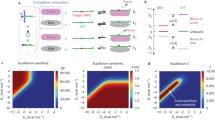Abstract
In developing hybridization-based DNA computing methods, DNA codes must be created that behave as predicted; otherwise computing errors can result. Here we describe the experimental validation of two DNA codes, each containing 16-nucleotide strands designed to hybridize only with their complements and not with themselves or with any other strands in the set. Code I was constructed simply to restrict potential for cross-hybridized (CH) secondary structure. Code II was constructed using the software SynDCode, incorporating nearest-neighbor thermodynamics and generalizations of the Levenshtein edit distance. Every combination of strands was tested for potential to mispair, both in individual pairings and in pools. Since the strands are designed to be linked together in a long bit string, we also tested end-to-end junctions of Code II strands. Hybridization was examined by measuring fluorescence as a function of temperature in the presence of SYBR Green I, a dye whose fluorescence increases exponentially when bound to double-stranded DNA. This method shows promise as a means for rapid experimental validation of large numbers of sequences.
Preview
Unable to display preview. Download preview PDF.
Similar content being viewed by others
References
Borer, P.N., Gengler, B., Jr. Tinoco, I.: Stability of ribonucleic acid double-stranded helices. J. Mol. Biol. 86, 843–853 (1974)
Freier, S.M., Sugimoto, N., Sinclair, A., Alkema, D., Neilson, T., Kierzek, R., et al.: Stability of XGCGCp- GCGCYp- and XGCGCYp helixes: an empirical estimate of the energetics of hydrogen bonds in nucleic acids. Biochemistry 25, 3214–3219 (1986)
Allawi, H.T., SantaLucia Jr., J.: Thermodynamics and NMR of internal G-T mismatches in DNA. Biochemistry 36, 10581–10594 (1997)
McDowell, J.A., Turner, D.H.: Investigation of the structural basis for thermodynamic stabilities of tandem GU mismatches: solution structure of (rGAGGUCUC)2 by two-dimensional NMR and simulated annealing. Biochemistry 35, 14077–14089 (1996)
Zipper, H., Brunner, H., Bernhage, J., Vitzthum, F.: Investigations on DNA intercalation and surface binding by SYBR Green I, its structure determination and methodological implications. Nucleic Acids Res. 32(12), e103 (2004)
D’yachkov, A.G., Macula, A., Pogozelski, W.K., Renz, T.E., Rykov, V., Torney, D.C.: An insertion-deletion like metric with application to DNA hybridization thermodynamic modeling. In: Ferretti, C., Mauri, G., Zandron, C. (eds.) DNA 2004. LNCS, vol. 3384, pp. 90–103. Springer, Heidelberg (2005)
Bishop, M., Macula, A.J., Pogozelski, W.K., Renz, T.E., Rykov, V.V.: SynDCode: Cooperative DNA code generating software. In: Carbone, A., Pierce, N.A. (eds.) DNA 2005. LNCS, vol. 3892. Springer, Heidelberg (2006)
Lipsky, R.H., Mazzanti, C.M., Rudolph, J.G., Xu, K., Vyas, G., Bozak, D., Radel, M.Q., Goldman, D.: DNA melting analysis for detection of single nucleotide polymorphisms. Clinical Chemistry 47, 635–644 (2001)
Author information
Authors and Affiliations
Editor information
Editors and Affiliations
Rights and permissions
Copyright information
© 2006 Springer-Verlag Berlin Heidelberg
About this paper
Cite this paper
Pogozelski, W.K., Bernard, M.P., Priore, S.F., Macula, A.J. (2006). Experimental Validation of DNA Sequences for DNA Computing: Use of a SYBR Green I Assay. In: Carbone, A., Pierce, N.A. (eds) DNA Computing. DNA 2005. Lecture Notes in Computer Science, vol 3892. Springer, Berlin, Heidelberg. https://doi.org/10.1007/11753681_20
Download citation
DOI: https://doi.org/10.1007/11753681_20
Publisher Name: Springer, Berlin, Heidelberg
Print ISBN: 978-3-540-34161-1
Online ISBN: 978-3-540-34165-9
eBook Packages: Computer ScienceComputer Science (R0)




